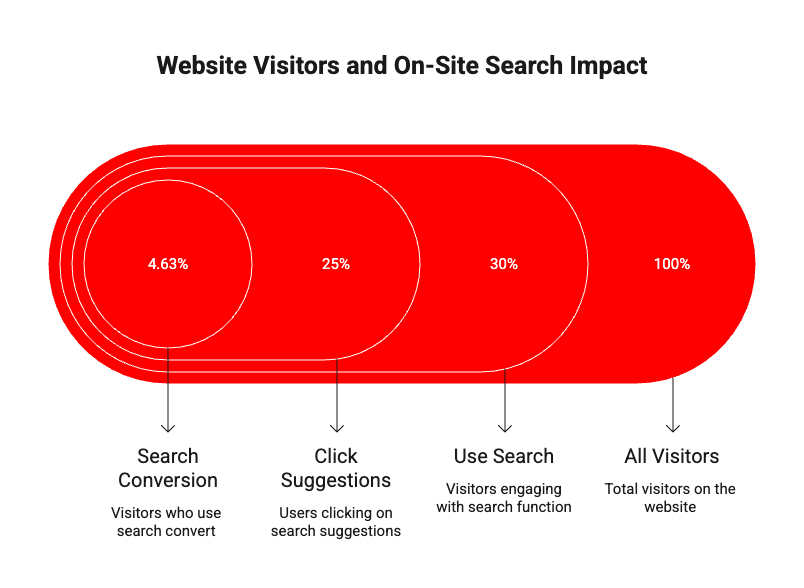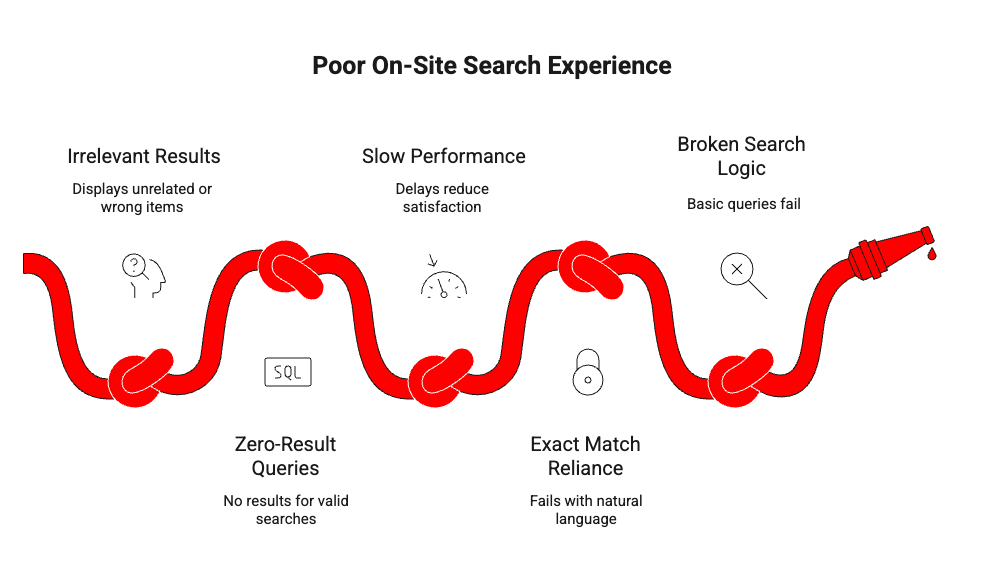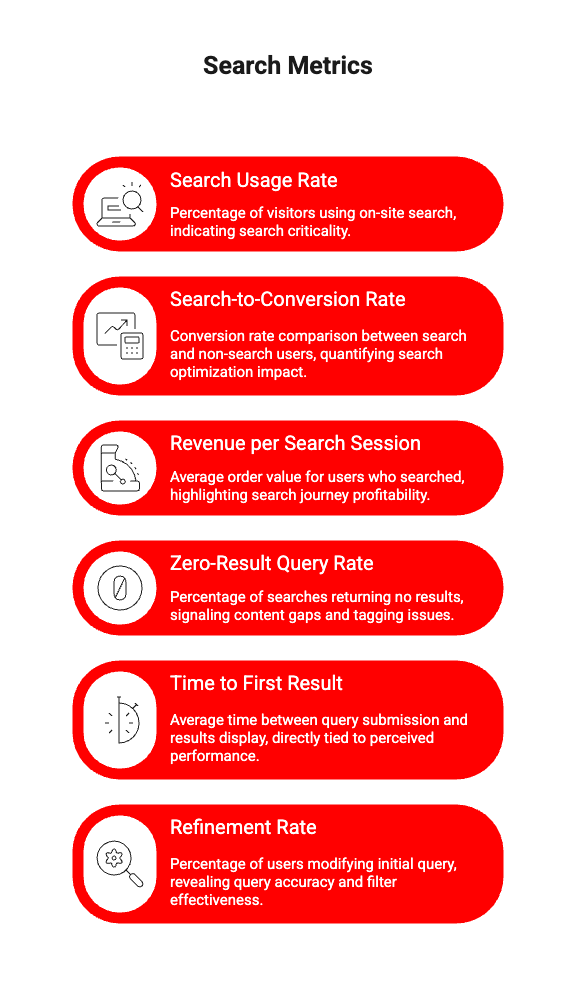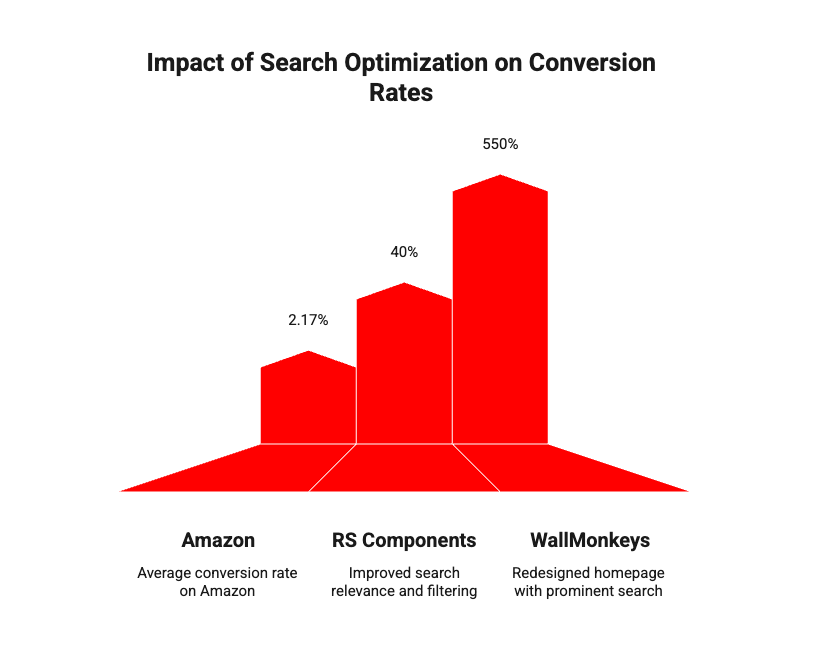What Is Bot and Boot? Unleashing the Best of E-commerce with Offshore Talent


Imagine if something as small as your website’s search bar could double your conversions. When visitors use on-site search, they’re signaling clear purchase intent. Up to 30% of eCommerce visitors rely on the search bar – and these searchers convert at rates up to 50% higher than average shoppers.
According to Baymard Institute’s, 41% of sites don’t have proper support for these essential search query types, which severely impacts users’ ability to find what they’re looking for. Meaning nearly half of all users may hit dead ends even when their intent is crystal clear.
This demonstrates how critical an on-site search is, not simply as a UX feature but as an important aspect of conversion optimization. The right implementation guides users smoothly through the customer journey, encourages them to engage, and creates actions based on intent.
On-site search is much more than a navigation feature; it’s a high-intent touchpoint that strongly influences purchasing behavior. When visitors reach for your search bar, they’re signaling a readiness to buy, and the Econsultancy data backs that up:
Visitors who use search convert at 4.63%, compared to the site-wide average of 2.77%, making search-driven sessions nearly 1.8× more effective.
Around 30% of all visitors engage with the search function, a significant segment that’s closer to the end of the purchase funnel.
Approximately 25% of users will click on search suggestions, affirming the role autocomplete and smart prompts play in discovery.
These users contribute a substantial 13.8% of total revenue, despite being a smaller portion of traffic.
This combination of high-intent behavior and conversion efficiency makes on-site search an essential component of any effective conversion optimization strategy.
Why does this matter? On-site search is definitely not only a feature but a conversion driver as well. When effectively executed, it makes the search of products quicker, establishes the confidence of the client, and allows the user to make a decision faster.

On-site search is an important part of the overall importance of the customer’s experience (UX) on websites, and despite its importance, this part of the experience has perhaps been the most neglected in terms of website UX.
Here are the most critical issues that continue to plague on-site search across industries:
According to Forrester, up to 68% of users abandon or churn due to a poor search experience.
Why this happens:
What it leads to:
Many search engines fail at the most basic level, delivering valid results to valid queries.
By the numbers:
Underlying causes:
Impact:
A Baymard Institute study shows that 71% of websites only return results when users enter exact product titles or metadata.
Why this matters:
Example scenarios:
Consequences:
79% of consumers say on-site search often displays unrelated items.
Causes:
Example:
Result:
Receiving no results at all is one of the fastest ways to lose a customer. A reported 53% of users abandon their cart after a zero-result query.
Common reasons:
Impact:
Even minor delays in displaying results can derail an otherwise good search experience.
Performance benchmark:
Technical causes:
Business outcomes:

A good search experience helps users not only discover products but also feel understood. Improving on-site search is designed with purpose, logic-based, and builds across all devices. Here are actionable tactics that transform search from a simple tool to a legitimate conversion machine.
Search is often the first touchpoint for users with high intent. If it’s hard to find or slow to respond, they may never reach your product pages.
What to implement:
Autocomplete simplifies the search process and reduces input errors. It’s one of the easiest ways to improve usability and encourage exploration.
What it should include:
Search that only matches exact words misses the mark. Today’s users expect results that reflect what they meant, not just what they typed.
How to improve relevance:
Search results without filters can overwhelm users. Filters give shoppers the tools they need to make faster, more confident decisions.
Best practices for filtering:
A dead-end in search creates frustration. When users see “no results found,” many will leave immediately. A better fallback experience keeps them engaged.
What to offer instead:
Mobile shoppers expect simplicity and speed. If the search interface doesn’t adapt to small screens or requires too much effort, users drop off quickly.
How to design for mobile:
Search should evolve as users interact with your site. When results reflect preferences or past behavior, it feels less like a tool and more like guidance.
What to personalize:
Making your site’s search better durable is not a single action – it’s a continuous process that includes user experience, performance, and content quality. Your on-site search can lead to exposure and conversions with the help of this checklist.

| Metric | What It Measures | Why It Matters |
| Search Usage Rate | % of visitors who use on-site search | Identifies how critical search is to your flow |
| Search-to-Conversion Rate | Conversion rate of search users vs non-search users | Quantifies lift from optimized search |
| Revenue per Search Session | Average order value for users who performed a search | Highlights profitability of search journeys |
| Zero-Result Query Rate | % of searches returning no results | Signals content gaps and tagging issues |
| Time to First Result | Average time between query submission and results display | Directly tied to perceived performance |
| Refinement Rate | % of users who modify initial query | Reveals query accuracy and filter effectiveness |
Amazon’s search bar isn’t just functional; it’s a growth engine. According to Nacho Analytics:
That’s nearly 6× higher conversions, clear evidence that users who search are ready to buy. Amazon’s success shows how optimizing search relevance, speed, and UI can directly impact revenue.
By improving search relevance and implementing faster, more intuitive filtering (e.g., reducing filter selection time from 10 to 3.2 seconds), RS Components saw:
This shows how small UX design enhancements in search flow can lead to major revenue gains.
After redesigning its homepage to feature a prominent search bar and cleaner interface, WallMonkeys achieved:
The case underscores that simply making search accessible and intuitive can dramatically boost site engagement and conversion outcomes.

Enhancing your site’s search experience isn’t a one-time fix – it’s an ongoing process that touches UX, performance, and content quality. Use this checklist to ensure your on-site search drives both discovery and conversions.
Site search is not just a nice-to-have; it’s a direct route to increased conversion, satisfied customers, and enhanced engagement. The evidence from the data and case studies show that site search optimization affects the customer journey at every stage – from discovery through to decision-making.
If you have high exit rates, zero-result frustrations, or underperforming filters, the right tactics can open up a substantial amount of business value.
RBM Soft is the provider of strategic consulting and technical implementation services for enterprise search intelligence initiatives. Our methodology is a combination of industry-proven frameworks with customized solutions that are developed to address your unique business goals, customer behaviors, and competitive positioning.If you want to use search as your competitive advantage, get in touch with RBM Soft so you can deliver on-site experiences that are more intelligent, quicker, and conversion-driven.